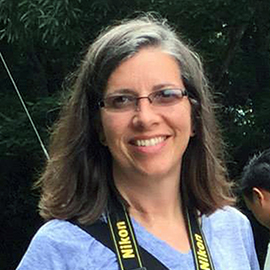
Dr. Ruth Carmichael
Bio
- Professor, University of South Alabama
- Senior Marine Scientist III, Dauphin Island Sea Lab
- Ph.D. 2004, Boston University
Emphasis: Marine Ecosystem Response
Research Interests
My research focuses on marine ecosystem responses; understanding relationships between organisms and their environment and specific biological and physiological responses to environmental change. In particular, I am interested in the mechanisms by which anthropogenic-driven perturbations affect coastal habitats and species. I give special focus to commercially important coastal bivalves, horseshoe crabs, manatees and dolphins.
I use a variety of approaches to make these assessments. I measure how perturbations affect habitat and food quality for consumers, and then determine the extent to which these effects may be transferred up coastal food webs in terms of change in growth, survival, and physiology. I also employ natural abundance stable isotopes to trace N and C sources from consumers to their food sources and ultimately to N and C sources from land. I use this information to discern trophic interactions, define linkages between anthropogenic factors and organism responses, assess nutritional importance of food sources, discern physiological state of organisms, and historically trace responses to environmental change.
Current Research Grants
-
National Fish and Wildlife Foundation (NFWF) - Alabama Marine Mammal Conservation and Recovery Program. 2015-2020
-
Alabama Division of Wildlife and Freshwater Fisheries - Aerial mapping of manatee thermal refugia in Alabama waters: Defining essential habitat. 2015-2017
-
U.S. Fish and Wildlife Service - Decadal scale documentation of endangered West Indian manatee habitat use in the northern Gulf of Mexico west of Florida. 2016-2018
-
WHOI Sea Grant Program - A history of mercury impacts to Waquoit Bay, MA clams. 2014-2017
Publications
-
Cloyed, C.S., K.P. DaCosta, M.R. Hodanbosi, and R.H. Carmichael. The effects of lipid extraction on δ13C and δ15N values and use of lipid-correction models across tissues, taxa and trophic groups. Methods Ecol Evol. 00:1-12. DOI: 10.1111/2041-210X.13386.
-
Deming, A.C., N.L. Wingers, D. P. Moore, D. Rotstein, R. S. Wells, R. Ewing, M. R. Hodanbosi, and R. H. Carmichael. Health Impacts and Recovery From Prolonged Freshwater Exposure in a Common Bottlenose Dolphin (Tursiops truncatus) Front. Vet. Sci.. Vol. 7(235). doi.org/10.3389/fvets.2020.00235.
2019
-
Collins, M.K., R.H. Carmichael, D.S. Rotstein, J.H. Byrd, and A.C. Deming. Suspected broadhead arrow injuries in two common bottlenose dolphins (Tursiops truncatus) along the Alabama Coast. Marine Mammal Science. DOI: 10.1111/mms.12667.
-
Hays, G.C., H. Bailey, S.J. Bograd, W.D. Bowen, C. Campagna, R.H. Carmichael, and et. al.. Translating Marine Animal Tracking Data into Conservation Policy and Management Trends in Ecology & Evolution. 2491. doi.org/10.1016/j.tree.2019.01.009.
-
Gancel, H.N., R.H. Carmichael, K. Park, J.W. Krause, and S. Rikard. Field Mark-Recapture of Calcein-Stained Larval Oysters (Crassostrea virginica) in a Freshwater-Dominated Estuary. Estuaries and Coasts. doi.org/10.1007/s12237-019-00582-6.
-
Sequeira, A.M.M., M.R. Heupel, M.-A. Lea, V.M. Eguiluz, C.M. Duarte, M.G. Meekan, M. Thums, H.J. Calich, R.H. Carmichael, D.P. Costa, L.C. Ferreira, J. Fernandez-Garcia, R. Harcourt, A.-L. Harrison, I. Jonsen, C.R. McMahon, D.W. Sims, R.P. Wilson, and G.C. Hays. The importance of sample size in marine megafauna tagging studies. Ecological Applications. 0(0). e01947.
-
Cloyed, C.S., E.E. Hieb, M.K. Collins, K.P. DaCosta, and R.H. Carmichael. Linking use of ship channels by West Indian Manatees (Trichechus manatus) to seasonal migration and habitat use. frontiers in Marine Science. 6:318. doi: 10.3389/fmars.2019.00318.
-
Murray, R., R.H. Carmichael, M.K. Collins, M.L. Russell, and A.C. Deming. Dead or Alive: Use of Elemental Analysis to Determine Status of Stranded Perinate Bottlenose Dolphins (Tursiops truncatus). Gulf and Caribbean Research. Vol. 30 (1)
2018
-
Patterson, H.K. and R.H. Carmichael. Dissolved oxygen concentration affects Delta 15N values in oyster tissues: implications for stable isotope ecology Ecosphere. Volume9(3). Article e02154.
-
Grüss, A., M.D. Drexler, C.H. Ainsworth, J.J. Roberts, R.H. Carmichael, N.F. Putman, P.M. Richards, E. Chancellor, E.A. Babcock, and M.S. Love.. Improving the spatial allocation of marine mammal and sea turtle biomasses in spatially explicit ecosystem models. Marine Ecology Progress Series. Vol. 602: 255–274.
-
D'Ambra, I., W.M. Graham, R.H. Carmichael, F.J. Hernandez, Jr.. Dietary overlap between jellyfish and forage fish in the northern Gulf of Mexico. Marine Ecology Progress Series. Vol. 587; 31-40.
-
Sequeira, A. M. M., J. Rodríguez, V. Eguíluz, R. Harcourt, M. Hinde, D. Sims, C. Duarte, D. Costa, Fernández-Gracia, L. Ferreira, G. Hays, M. Heupe, M. Meekan, A. Aven, F. Bailleul, A. Baylis, M. Berumen, C. Braun, J. Burns, J. Caley, R. Campbell, R. H. Carmichael, et al.. Convergence of marine megafauna movement patterns in coastal and open oceans PNAS. p.201716173.
2017
-
Darrow, E. S., R. H. Carmichael, C. F. T. Andrus, H. E. Jackson. From middens to modern estuaries, oyster shells sequester source-specific nitrogen. Geochimica et Cosmochimica Acta 202:39-56
- Krause, J., E. Darrow, R. Pickering, R. H. Carmichael, A. Larson, J. Basaldua. Reactive Silica Fractions in Coastal Lagoon Sediments from the Northern Gulf of Mexico. Cont. Shelf Res. 151(2017):8-14. doi: 10.1016/j.csr.2017.09.014
- Hohn, A., L. Thomas, C. Booth, R. H. Carmichael, J. Litz, D. Shannon, S. Shippee, C. Sinclair, S. Smith, T. R. Speakman, M. Tumlin, E. Zolman.. Assigning Stranded Dolphins to Stock using Stable Isotope Ratios following the Deepwater Horizon Oil Spill. Endanger. Species Res. 33:235-252
-
Hieb, E.E., R.H. Carmichael, A. Aven, C. Nelson-Seely, N. Taylor. . Sighting demographics of the West Indian manatee (Trichechus manatus) in the north central Gulf of Mexico. Endangered Species Research 32:321-332
-
Fauquier, D. A., J. Litz, S. Sanchez, K. Colegrove, L. Schwacke, L. Hart, J. Saliki, C. Smith, T. Goldstein, S. Bowen-Stevens, W. McFee, E. Fougeres, B. Mase-Guthrie, E. Stratton, R. Ewing, S. Venn-Watson, R. H. Carmichael, C. Clemons-Chevis, D. Shannon, S. Shippee, S. Smith, L. Staggs, M. Tumlin, N. Wingers, T. Rowles. Evaluation of Morbillivirus Exposure in Cetaceans from the Northern Gulf of Mexico 2010-2014. Endangered Species Research, 33:211-220.
Courses
- Marine Conservation Biology
- Marine Invertebrate Zoology
- Scientific Communication
- Stable Isotope Ecology Seminar
- Biology and Conservation of Horseshoe Crabs


